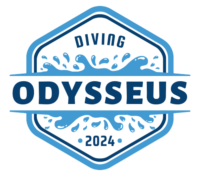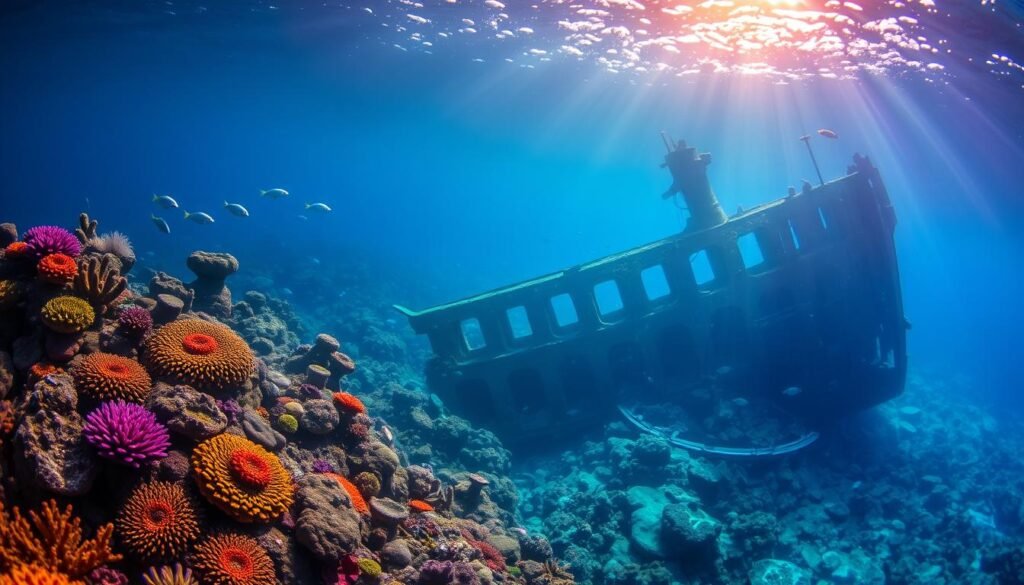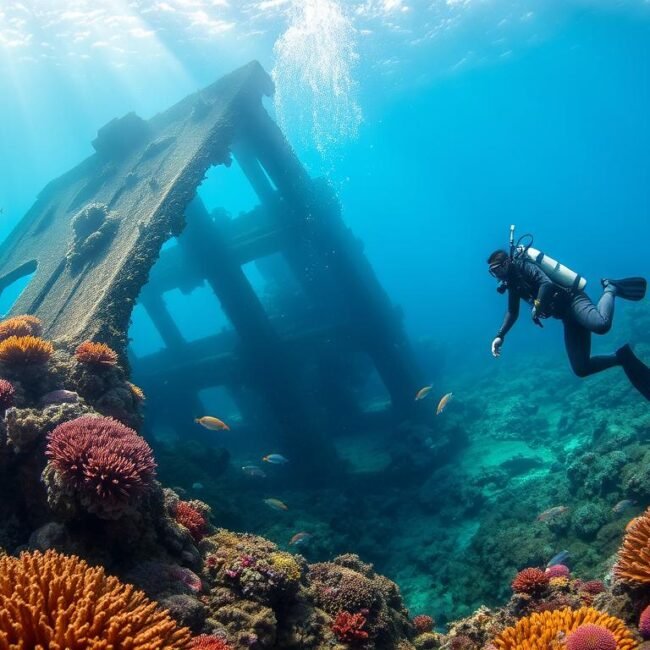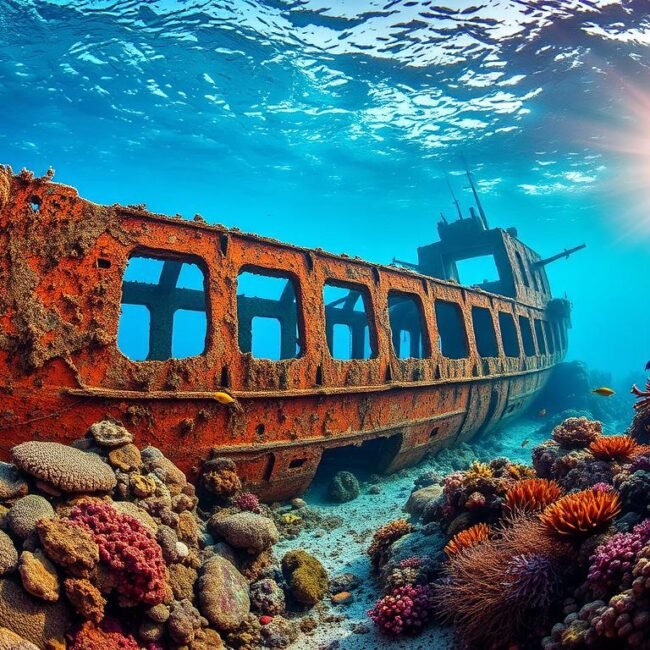“Did you know there are millions of shipwrecks on the seafloor? It’s like an underwater museum. With the right wreck diving courses, even beginners can explore it all.
Wreck diving is more than just old ships. It’s a peek into history and a chance to see marine life. I was worried about getting lost or feeling out of place. But, with the right training, it feels like an adventure, not a mess.
This guide will explain why wreck diving is so cool. We’ll talk about how wreck diving courses can make you feel confident. Plus, we’ll cover safety, gear, and the best places to dive. Ready to explore some amazing underwater sites? Let’s dive in!
Understanding the Appeal of Wreck Diving
Brief History of Wreck Diving and Why It’s So Popular
Wreck diving, in its earliest form, started before we had fancy SCUBA gear. Ages ago, free divers and hard-hat divers ventured underwater, often out of necessity rather than curiosity. Some wanted salvage; others were driven by sheer wonder. Fast-forward to the modern era, and wreck diving evolved into a specialized discipline.
It gained popularity partly because of improved technology—like better dive computers, buoyancy control devices, and reliable regulators—that made it safer and more accessible than ever before.
I still remember reading old magazines about pioneering divers who discovered lost vessels using rudimentary equipment. The idea that people explored wrecks without the slick training we have today amazes me. Now, thanks to modern wreck-diving-courses, we can do it far more comfortably, learning from decades of collective experience.
The Allure of Exploring Sunken Vessels and Aircraft
If you’re anything like me, stepping into a sunken ship feels like entering another universe. I’ll never forget my first glimpse of a massive hull covered in marine growth, with fish swimming through what used to be doorways. Every wreck has its own mood. Some are hauntingly serene; others are teeming with colorful coral and curious creatures.
And it’s not just ships—there are aircraft wrecks out there, too! Imagine gliding through the fuselage of an old plane, marveling at the interplay between human history and nature’s creativity.
There’s this distinct thrill in discovering secret compartments or spotting a turtle lounging by a porthole. It’s a form of underwater time travel, giving you a taste of the past while surrounded by present-day life. I once found an old, rusted wrench inside a wreck’s engine room. Sure, it wasn’t treasure, but it told a silent story about the crew who worked there before the ocean claimed their vessel.
For newbies, wreck-diving-courses are a must. Without training, diving can feel overwhelming. You might find yourself lost in narrow corridors or struggling with poor visibility.
A good course teaches you how to handle a reel and manage your buoyancy. It also shows you what to do if you get tangled in debris. During my course, I learned to navigate safely and confidently.
These courses teach you to respect the wreck and its marine life. They help you avoid damaging the wreck or disturbing the marine life. In short, a wreck-diving-course is about safety, appreciation, and adventure.
“Wreck diving offers a unique opportunity to explore history firsthand, but it must be approached with the utmost caution and respect for the environment.”
Top Reasons Beginners Should Enroll in a Wreck Diving Course
Safety First: Learning Essential Techniques to Prevent Accidents
I was nervous about wreck diving at first. I worried about getting trapped or snagged. But a wreck-diving-course showed me how to avoid these dangers.
You’ll learn important safety protocols, like how to run a guideline. Instructors will teach you how to handle low visibility and unexpected hazards. This training gives you the confidence to dive safely.
I once saw a diver try to dive a small wreck without training. They stirred up so much sediment they couldn’t find their exit. Luckily, they got out safely, but it was a scary lesson. With a course, you learn to handle these situations calmly.
Building Foundational Skills for Advanced Dives Later
A wreck-diving-course is like a stepping stone. It prepares you for more challenging dives in the future. You’ll learn essential skills like buoyancy control and spatial awareness.
These skills are useful in other diving forms too. After wreck diving, my reef dives became easier. I was more aware of my body’s position in the water.
Access to Guided Training with Experienced Instructors
Learning from experienced instructors is the best part of wreck-diving-courses. My instructor was like a wreck-diving encyclopedia. He shared stories about weird creatures and unexpected currents.
Getting personalized feedback during practice dives helps you improve faster. You can’t learn these subtle tricks from videos or books. Having an instructor by your side gives you peace of mind.
When I first tried running a reel line inside a wreck, I struggled. Instead of panicking, I signaled my instructor, and we sorted it out. This mentorship ensures you’re not just learning in theory, but truly mastering the skills.
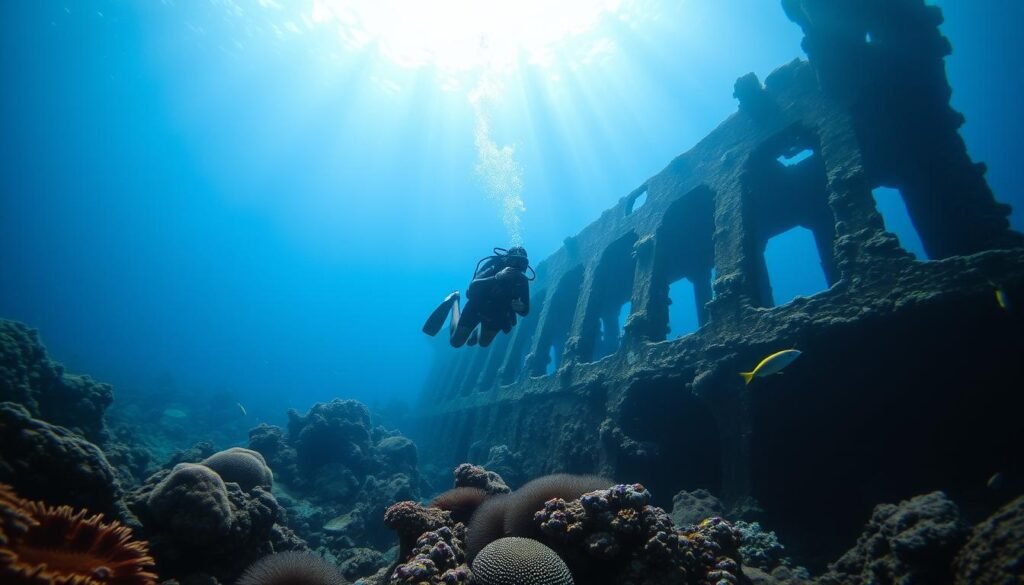
Key Elements of a Quality Wreck Diving Course
Comprehensive Theory Sessions Covering Safety and Navigation
A solid wreck-diving-course will load you up with knowledge before you dive. You’ll learn about wreck orientation, structural integrity, and potential hazards. I was surprised at how much theory we covered.
It’s like building a blueprint in your mind. Once you’re underwater, you have a mental map to guide you. Though I was itching to dive, I realized the theory part is crucial.
Practical Dives Under Expert Supervision
Getting wet is the best part after learning. Practice dives let you try out what you’ve learned. On my first dive, I struggled with buoyancy and bumped into a railing. My instructor just gave me a thumbs-up, reminding me to relax and adjust.
By the second and third dives, I moved better and even looked into compartments without causing a mess.
These dives also teach you how to use special gear like reels and lights. Learning to use a dive reel in a wreck is harder than it seems. But, with expert help, you get feedback right away to improve for the next dive.
Emphasis on Buoyancy, Communication, and Emergency Preparedness
Learning to control your buoyancy is a big plus from a wreck-diving course. I used to move up and down like a beginner. But inside a wreck, you need to move slowly and carefully to avoid damage.
By the end of my course, I could stay steady underwater. This skill helped me in every dive I did after.
Learning to communicate and handle emergencies is also key. You’ll learn special hand signals and how to stay calm in emergencies. Practicing these drills made me feel more confident and ready for anything.
“Wreck diving is not just about swimming around a submerged ship – it’s about respecting the history, environment, and potential hazards that come with these incredible underwater treasures.”
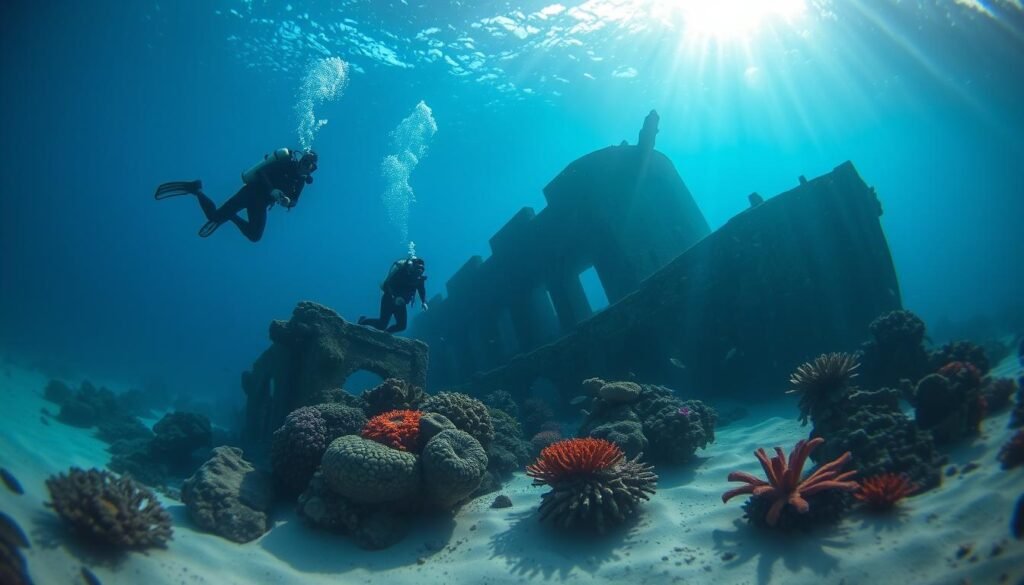
Best Certification Agencies for Beginner Wreck Divers
PADI: Wreck Diver Specialty Overview and Requirements
PADI is well-known in diving. Their Wreck Diver Specialty teaches you the basics. I learned about mapping wrecks and using penetration lines safely. The course is detailed but not overwhelming.
You need some dives and your Open Water certification to start. By the end, I felt like a true explorer.
SSI: Wreck Diving Certification Details and Benefits
Scuba Schools International (SSI) offers a wreck diving course that beginners like. They use digital learning, so you can learn at your own pace. My friend took an SSI course and loved the interactive online materials.
The practical sessions focused on buoyancy and navigation. SSI’s global recognition makes your certification useful everywhere you dive.
NAUI: Training Approach and Global Recognition
The National Association of Underwater Instructors (NAUI) focuses on safety. Their courses are detailed and safety-focused. NAUI’s training is hands-on and scenario-based, which some people prefer.
NAUI certifications are respected worldwide. I’ve met divers who say NAUI prepared them for challenges better than other agencies. Choose an agency that fits your learning style, but always aim to build confidence and safety awareness.
Choosing the Right Destination for Your Wreck Diving Course
The Caribbean: Warm Waters and Accessible Shallow Wrecks
The Caribbean is perfect for beginners. Its warm, clear waters feel like a big pool. You can see coral and fish everywhere.
Many wrecks are shallow, so you won’t feel too much pressure. I did a course here and saw the whole ship outline from above. The marine life, like colorful angelfish, makes diving more exciting.
READ MORE: Best Caribbean Top Dive Destinations for Adventure
Southeast Asia: Historic World War II Wrecks in the Philippines
Southeast Asia is great for history lovers. The Philippines has many WWII wrecks. Diving here feels like stepping into history.
One wreck I explored had old ammunition around. It made me think of the crew who served there. The water is warm, but visibility can change. It’s a good choice for those who want a deeper history.
READ MORE: Top 10 Dive Sites in the Philippines for Unforgettable Dives
Red Sea: Pristine Wreck Sites Teeming with Marine Life
The Red Sea in Egypt or Sudan has amazing wrecks. The SS Thistlegorm is famous. I saw motorbikes and trucks still in her cargo hold.
The Red Sea’s clear water and vibrant corals are a bonus. But, it takes more planning to get there. Choosing a destination depends on your comfort, budget, and what you want to see.
READ MORE: Best Red Sea Diving Spots: Underwater Paradise Awaits
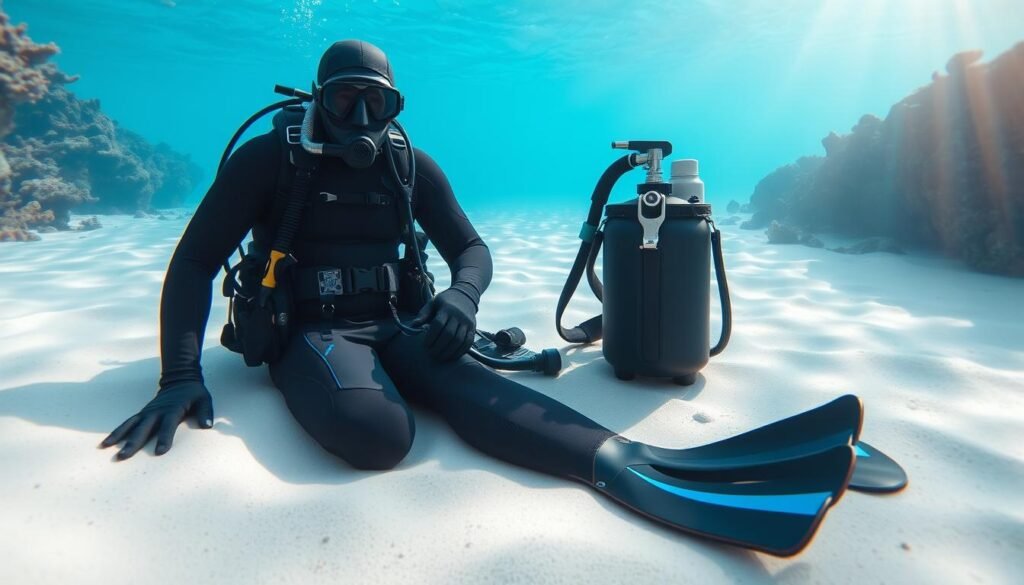
Essential Skills Taught in Beginner Wreck Diving Courses
Proper Use of Dive Lights and Reels
Dive lights are essential in wrecks. Sunlight doesn’t reach all areas. Learning to use them without blinding your buddy is hard.
Reels are also crucial. I learned to use them to mark a path back to the surface. It takes practice, but it’s worth it.
Navigating Tight Corridors and Confined Spaces
Wrecks have narrow spaces. You need to move carefully to avoid damage. Your course will teach you how to do this.
I remember my first tight space. My heart was racing, but I followed my training. It felt amazing to pass through smoothly.
Maintaining Neutral Buoyancy to Protect Both Diver and Wreck
Buoyancy is key in wreck diving. It keeps you safe and respects the wreck. We practiced buoyancy drills a lot.
Once I mastered it, diving felt effortless. I moved smoothly, leaving only bubbles behind.
Recommended Equipment for Wreck Diving Beginners
Full Scuba Setup with Regulators and BCDs
When starting wreck diving, get the basics right. A good regulator and a fitting BCD are key. I chose a BCD that felt like a second skin, giving me confidence underwater.
A reliable regulator lets you breathe easily. This means you can focus on navigating without worrying about your gear.
Wreck-Specific Gear: Reels, Dive Lights, Line Cutters
For wreck diving, you need special gear. A sturdy dive reel is essential for creating a safe path inside the wreck. Choose one with a smooth spool and a handle that fits your gloved hand.
Dive lights are a must. Even if the entrance is bright, the wreck’s interior might be dark. Carry a primary light and a backup. A line cutter is also crucial. It helps you quickly cut through any tangles.
Optional Tech Gear: Cameras, Strobes, and Underwater Compasses
For documenting your dives, consider underwater cameras and strobes. They capture the wreck’s beauty. But don’t forget to stay aware of your surroundings while filming.
An underwater compass is handy, especially in large wrecks. It helps you avoid getting lost. I learned this the hard way without a compass.
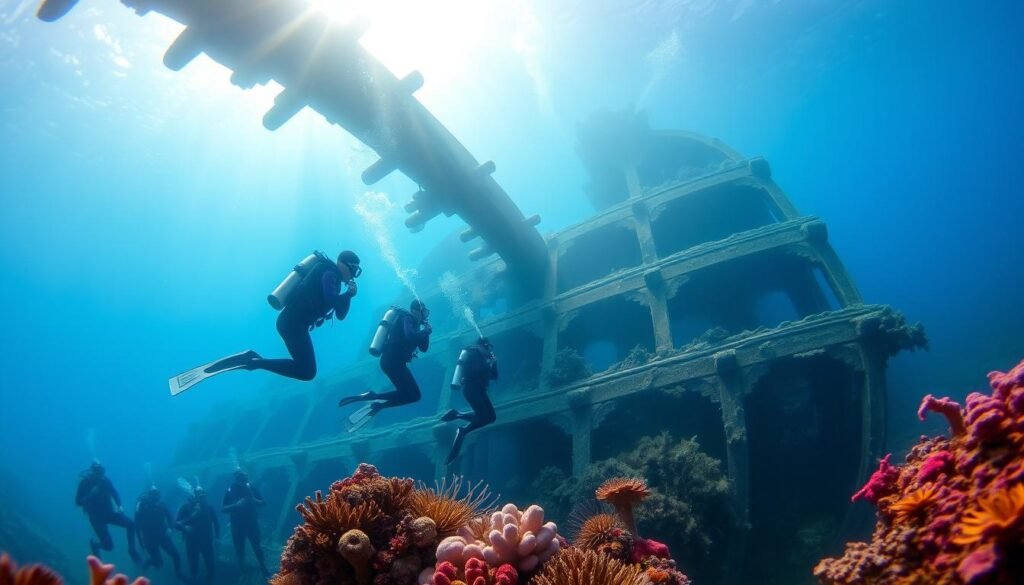
Costs and Course Length: What to Expect
Average Course Fees and What’s Included
Wreck-diving courses vary in price. They include professional instruction, multiple dives, and rental gear. Some courses also cover certification fees.
Before my first course, I wondered if it was worth it. After completing it, I knew it was. The skills and excitement made it worth every penny.
Additional Expenses: Gear Rental, Travel Costs, and Site Fees
Remember to budget for extras like gear rental and travel. Some sites also charge entry fees. I learned to budget for these costs the hard way.
Course Duration: From Weekend Workshops to Week-Long Intensives
Course lengths vary from weekends to a week. Longer courses offer more practice and confidence. If you can, choose a longer course for better skills.
Tips for Selecting Your Ideal Wreck Diving Course
Researching Instructor Credentials and Student Reviews
Don’t rush into the first course you see. Research the instructor’s background and read reviews. I chose a course with an experienced instructor who was also a great teacher.
Matching Course Level to Your Comfort and Experience
If you’re new, don’t dive into advanced wrecks right away. You’ll feel overwhelmed and miss key skills. Start with a beginner course.
Once you’ve got the basics, look for more challenging wrecks. Your instructor can guide you to courses that fit your growing skills. This way, you avoid diving too far, too fast.
Considering Class Size for Personalized Attention
Some courses have lots of students, while others are small. If you learn better with one-on-one feedback, choose a smaller class. It might cost more, but the personal attention is worth it.
My first wreck-diving course had only four students. We got lots of individual feedback. This made the experience more enjoyable and helped us bond.
“The combination of classroom learning, pool practice, and guided open water dives is essential for developing the knowledge and skills needed to explore wrecks safely and responsibly.”
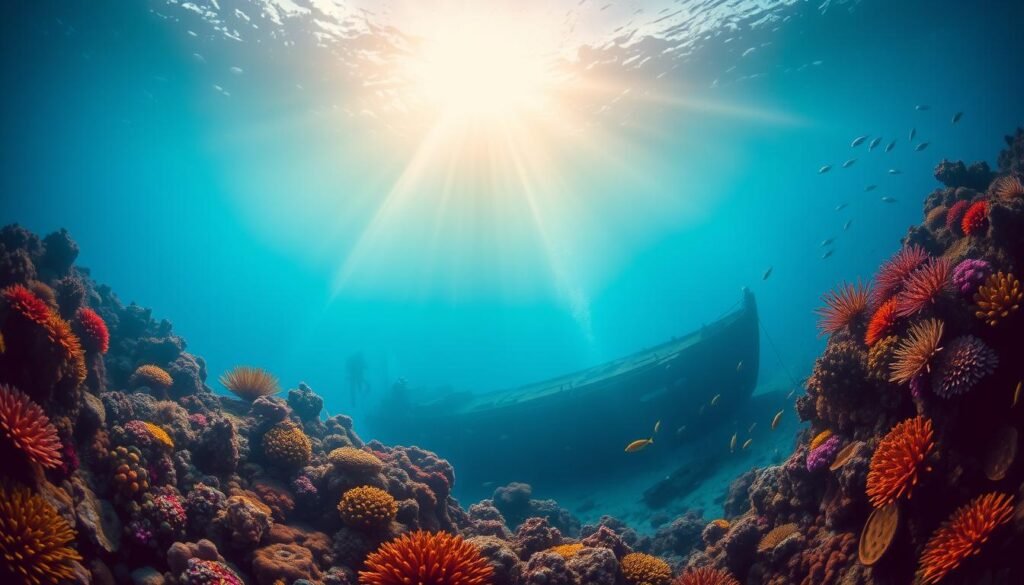
Common Beginner Mistakes and How to Avoid Them
Rushing Into Advanced Wrecks Without Proper Training
It’s tempting to dive the biggest wrecks right after getting certified. But slow down. Diving advanced wrecks without experience can lead to accidents. I saw someone dive too deep too soon and got lost.
Take your time and grow your skills. Dive safely and level up gradually.
Neglecting Pre-Dive Safety Checks
Skipping pre-dive checks can lead to simple mistakes. Always test your gear, check your buddy’s, and discuss your dive plan. I forgot to test my backup light and it didn’t work when I needed it.
Don’t be like me—always check your gear!
Panicking in Enclosed Spaces—How Training Can Help
Feeling claustrophobic in wrecks is normal. The key is to breathe slowly and trust your training. In a good wreck-diving course, you’ll practice emergency scenarios.
When I first dove a cramped passage, my heart raced. But I remembered the drills and stayed calm. Training helps you handle fear.
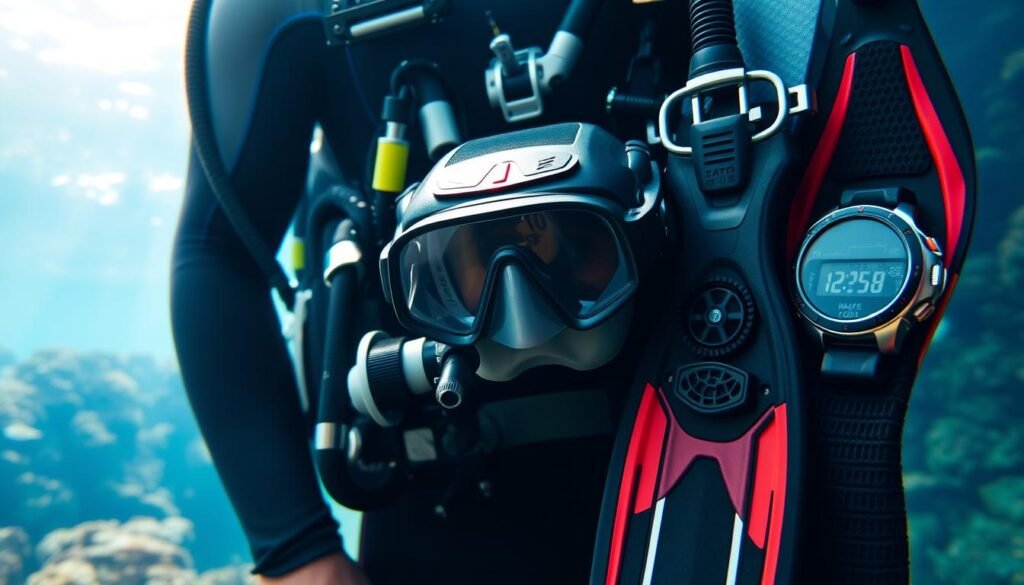
Post-Certification: Where Do You Dive Next?
Planning Your First Independent Wreck Dives
After getting certified, you’ll want to dive on your own. Start with a simple wreck you’ve dived with your instructor. I chose a wreck I knew well for my first solo dive.
Plan your dive carefully. Study maps, consider the depth, and pick the right buddy.
Joining Local Dive Clubs and Online Forums
Wreck diving has a great community. Join local clubs and online forums to learn and meet new people. I met a group of wreck enthusiasts after my certification.
We shared stories, planned trips, and recommended gear. It made wreck diving more than just a hobby.
Continuing Education for Advanced Wreck and Technical Diving
If you love wreck diving, you might want to dive deeper. Look for advanced courses in technical diving. These courses let you dive remote, challenging wrecks.
Remember, each step should build on your skills. Continuing your education makes every dive safer and more enjoyable.
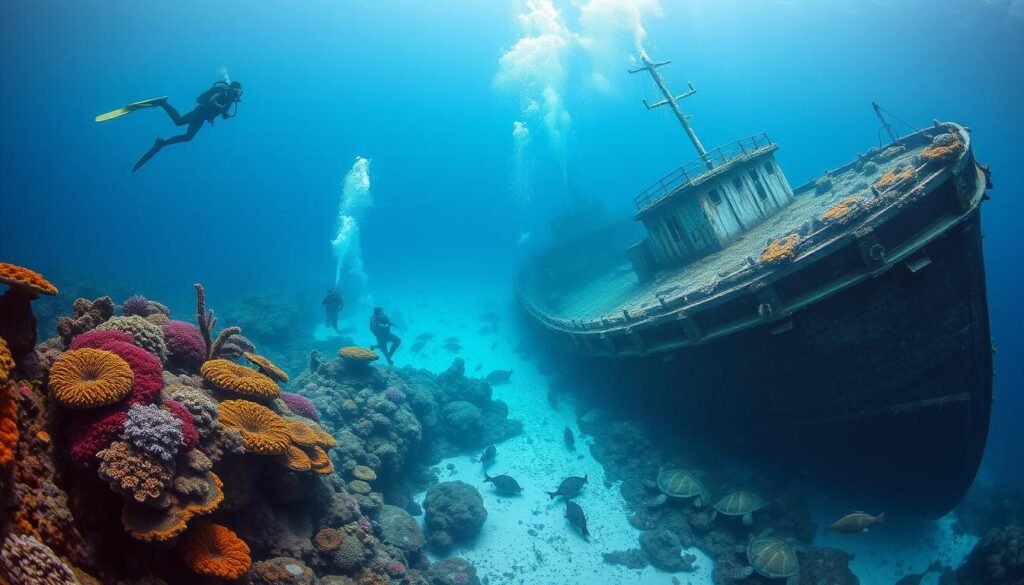
“The ocean is the lifeblood of our planet. If we protect the ocean, we protect ourselves.” – Sylvia Earle, renowned marine biologist and oceanographer
Conclusion
Wreck-diving-courses open a secret underwater world full of history, marine life, and mystery. They teach you to be confident, learn safety skills, and see the beauty in sunken ships. Even beginners can explore, shine lights in old cabins, and leave only bubbles behind.
Choose a course that fits your skill level, budget, and comfort. Ask questions, share stories, and post online. Stay safe, respect wrecks and their homes, and follow your training. Ready to dive in? Share your favorite wreck dive or ask for tips. The ocean is calling!
FAQs
Do I need any prior diving experience before enrolling in a wreck-diving-course?
Most courses need you to have an Open Water certification or some dives. This ensures you’re comfortable with basic scuba skills before wreck diving. It’s like learning to walk before running—starting with basics makes diving more fun and less scary.
How long does it usually take to complete a beginner wreck-diving-course?
Courses vary from weekend workshops to week-long intensives. Shorter courses cover basics, while longer ones offer more practice and theory. I prefer multi-day courses for better learning and confidence.
What should I bring to my first wreck-diving-course?
Bring your basic scuba gear if you have it. Some courses offer rentals, but your own gear is more comfortable. Don’t forget a dive computer, notes, sunscreen, and a jacket for chilly surface intervals.
Is wreck diving safe for beginners, or is it too risky?
With the right training, wreck diving is safe and exciting. Good courses teach you to navigate, stay buoyant, and handle emergencies. I was nervous at first, but practice dives and safety protocols eased my fears. Follow your training and choose suitable wrecks for a safe dive.
After I finish a beginner-level wreck-diving-course, what’s next?
Start planning dives on simpler wrecks and gradually tackle more challenging ones. Join dive clubs, explore online forums, and connect with other divers. You might also consider advanced certifications or technical diving courses. The ocean is a big playground—keep learning and exploring!
READ MORE: Master the Depths: Your Guide to Advanced Wreck Diving Courses in 2025
